2019 年广东广州大学综合英语考研真题
第一篇:
Flats were almost unknown in Britain until the 1850s when they were developed, along with
other industrial dwellings, for the laboring classes. These vast blocks were plainly a convenient
means of easing social conscience by housing large numbers of the ever-present poor on
compact city sites. During the 1880s, however, the idea of living in comfortable residential
chambers caught on with the affluent upper and upper-middle classes, and controversy as to the
advantages and disadvantages of flat life was a topic of conversation around many a respectable
dinner-table. In Paris and other major European cities, the custom whereby the better-off lived
in apartments, or fiats, was well established. Up to the late nineteenth century in England only
bachelor barristers had established the tradition of living in rooms near the Law Court: any
self-respecting head of household would insist upon a West End town house as his London home,
the best that his means could provide.
The popularity of flats for the better-off seems to have developed for a number of reasons. One
is the introduction of the railways, which had enabled a wide range of people to enjoy a holiday
staying in a suite at one of the luxury hotels which had begun to spring up during the previous
decade. Hence, there is no doubt that many of the early luxury fiats were similar to hotel suites,
even being provided with communal dining-rooms and central boilers for hot water and heating.
Rents tended to be high to cover overheads, but savings were made possible by these communal
amenities and by tenants being able to reduce the number of family servants.
One of the earliest substantial London developments of flats for the well-to-do was begun soon
after Victoria Railway Station was opened in 1860, as the train service provided an efficient link
with both the City and the South of England. Victoria Street, adjacent to both the Station and
Westminster, had already been formed, and under the direction of the architect, Henry Ashton,
was being lined, with blocks of residential chambers in the Parisian manner. These fiats were
commodious indeed, offering between eight and fifteen rooms apiece, including appropriate
domestic offices. The idea was an emphatic departure from the tradition of the London house
and achieved immediate Success.
Perhaps the most notable block in the vicinity was Queen Anne's Mansions, partly designed by
E.R. Robson in 1884 and recently demolished. For many years, this was London's loftiest building
and had strong claims to be the ugliest. The block modeled on the American skyscraper, and was
nearly 200 feet high. The cliff-like walls of dingy brick completely overshadowed the modest
thoroughfare nearby. Although bleak outside, the mansion fiats were palatial within, with
sumptuously furnished communal entertaining and dining rooms, and lifts to the uppermost
floors.
The success of these tall blocks of flats could not have been achieved, of course, without the
invention of the lift, or 'ascending carriage' as it was called when first used in the Strand Law
�
Courts in the 1870s.
1、 Flats first appeared in Britain in the middle of the 19th century when
A. they were principally built for those families with several servants.
B. people were not conscious of the crowded housing of the less well-to-do.
C. there was increasing concern over accommodation for the poor.
D. people became conscious of the social needs of the rural population.
2、 English upper-middle-class families preferred to
A. live mainly outside London, where it was healthier and cheaper.
B. live in the West End.
C. live near their working place.
D. live in London, but mainly not in the West End.
3、 One effect of the railways' coming to central London was to stimulate the building of
A. large and well-appointed hotels.
B. blocks of self-contained fiats.
C. rows of elegant town houses.
D. fiats similar to hotel suites.
4、 The immediate success of the flats in Victoria Street could be attributed to
A. the unusual number of rooms each fiat contained.
B. their revolutionary style of architecture.
C. the ease with which they could be used as offices.
D. their French style of architecture.
5、 Which of the following is true about the interior and exterior of Queen Anne's Mansions?
�
A. They were elegantly decorated both inside and outside.
B. They were grim from the outside and had a modest decor inside.
C. They were flashy from the street but nondescript inside.
D. They were plain outside but with lavish interior.
第二篇:
As a firefighter, I have seen many people die in hotel fires. Most could have saved themselves if
they had been prepared. Contrary to what you have seen in the movies, fire is not likely to chase
you down and burn you to death. It’s the by-products of fire-smoke and panic- that are almost
always the causes of death.
For example, a man wakes up at 2:30 am due to the smell of smoke. He pulls on his pants and
runs into the hallway-to be greeted by heavy smoke. He has no idea where the exit is, so he runs
first to the right. No exit. Where is it? Panic sets in. He’s coughing and gagging now; his eyes
hurt. He can t see his way back to his room. His chest hurt; he needs oxygen desperately. He rims
in the other direction, completely disoriented. At 2:50 am we find him dead of smoke inhalation.
Smoke, because it is warmer than air, will start accumulating at the ceiling and works its way
down. The fresh air you should breathe is near the floor. What ’s more, smoke is extremely
irritating to the eyes. Your eyes will take only so much irritation, then they will close and you
won t be able to open them.
Your other enemy, panic, can make you do things that could kill you. The man in the foregoing
example would not have died if he had known what to do. Had he found out beforehand where
the exit was four doors down on the left-he could have gotten down on his hands and knees
close to the floor, where the air is fresher. Then, even if he couldn't keep his eyes open, he could
have felt the wall as he crawled, counting doors.
1.
The major point discussed in the passage is (
)
A. a firefighter's job
В. How to cope with fire
C. the danger of fire
D. the real cause of death in fire.
2. Which of the following persons would most likely die in hotel fires?(
)
�
A. Those who get down on their hands and knees close to the door.
B. Those who leave the hotel at the first sign of smoke.
C. Those who look before they leap out of a low window.
D. Those who don t know where the exits are.
3. The man who died of smoke inhalation is an example given by the author to show(
)
A. the disastrous consequence of panic and smoke
B. the importance of precaution against fire
C. the disastrous consequence of a big hotel fire
D. the importance of being well-prepared in your room
4. According to the passage, which of the following is NOT true?(
)
A. Fire is unlikely to turn you to death directly.
B. Smoke and panic are almost always the causes of death.
C. You should keep calm in the hotel fire.
D. Movies show the right rules for surviving hotel fires.
5. The word "disoriented” (Para.2) means (
)
A. losing all sense of direction
B. losing all strength against fire
С. unable to see the way
D. mortally afraid
第三篇:
War may be a natural expression of biological instincts and drives toward aggression in the
human species. Natural impulses of anger, hostility, and territoriality are expressed through acts
of violence. These are all qualities that humans share with animals. Aggression is a kind of
innatesurvival mechanism, an instinct for self-preservation that allows animals to defend
�
themselves from threats to their existences of human violence are always conditioned by social
conventions that give shape to aggressive behavior. In human societies violence has a social
function. It is a strategy for creating or destroying forms of social order. Religious traditions have
taken a leading role in directing the powers of violence. We will look at the ritual and ethical
patterns within which human violence has been directed.
The violence within a society is controlled through institutions of law. The more developed a
legal system becomes, the more society takes responsibility for the discovery, control, and
punishment of violent acts. In most tribal societies the only means to deal with an act of
violence is revenge. Each family group may have the responsibility for personally carrying out
judgment and punishment upon the person who committed the offense. But in legal systems,
the responsibility for revenge becomes depersonalized and diffused. The society assumes the
responsibility for protecting individuals from violence. In cases where they cannot be protected,
the society is responsible for imposing punishment. In a state controlled legal system, individuals
are removed from the cycle of revenge motivated by acts of violence, and the state assumes
responsibility for their protection.
The other side of a state legal apparatus is a state military apparatus. While the one protects
the individual from violence, the other sacrifices the individual to violence in the interests of the
state. In war the state affirms its supreme power over the individuals within its own borders.
War is not simply a trial by combating to settle disputes between states; it is the moment when
the state makes its most powerful demands upon its people for their commitment allegiance,
and supreme sacrifice. Times of war test a community ’ s deepest religious and ethical
commitments.
31. Human violence shows evidence of being a learned behavior in that __.
A) it threatens the existing social systems
B) it is influenced by society
C) it has roots in religious conflicts
D) it is directed against institutions of law
32. The function of legal systems, according to the passage, is __.
A) to control violence within a society
B) to protect the world from chaos
C) to free society from the idea of revenge
D) to give the government absolute power
�
33. What does the author mean by saying “ in legal systems, the responsibility for revenge
becomes depersonalized and diffused”
A) Legal systems greatly reduce the possibilities of physical violence.
B) Offenses against individuals are no longer judged on a personal basis.
C) Victims of violence find it more difficult to take revenge.
D) Punishment is not carried out directly by the individuals involved.
34. The word “allegiance” is closest in meaning to __.
A) loyalty
B) objective
C) survival
D) motive
35. What can we learn from the last paragraph?
A) Governments tend to abuse their supreme power in times of war.
B) In times of war governments may extend their power across national borders.
C) In times of war governments impose high religious and ethical standards on their people.
D) Governments may sacrifice individuals in the interests of the state in times of war.
四、段落翻译
出自赛缪尔·斯迈尔斯的《以书为友》,以下是原文。
Books possess an essence of immortality. They are by far the most lasting products of human
effort. Temples and statues decay, but books survive. Time is of no account with great thoughts,
which are as fresh today as when they first passed through their authors' minds ages ago. What
was then said and thought still speaks to us as vividly as ever from the printed page. The only
effect of time has been to sift out the bad products, for nothing in literature can long survive but
what is really good.
Books introduce us into the best society; they bring us into the presence of the greatest minds
�
that have ever lived. We hear what they said and did; we see them as if they were really alive;
we sympathize with them, enjoy with them, grieve with them; their experience becomes ours,
and we feel as if we were in a measure actors with them in the scenes which they describe.
五、200 字作文
讨论在中国成绩不好的学生的家长为孩子申请国外学校的思考(foreign college or university
study)
�
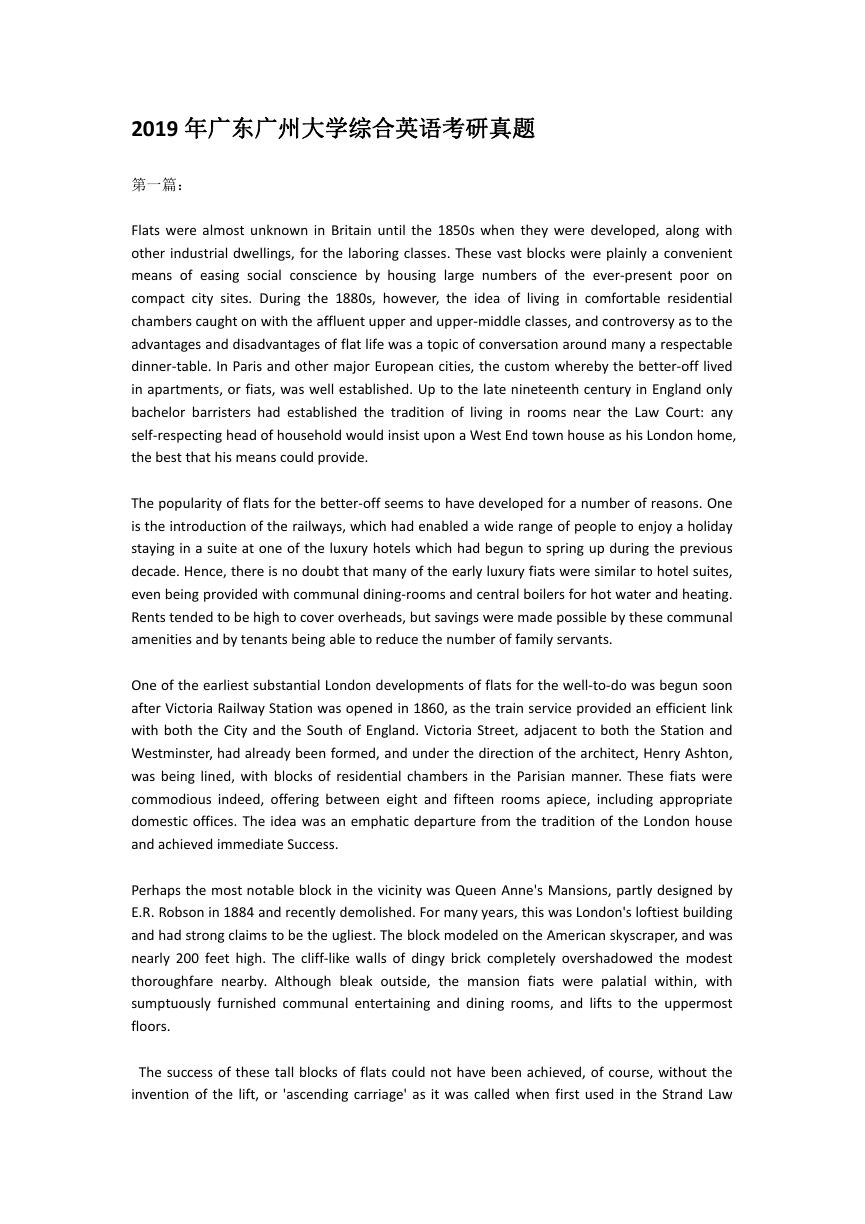
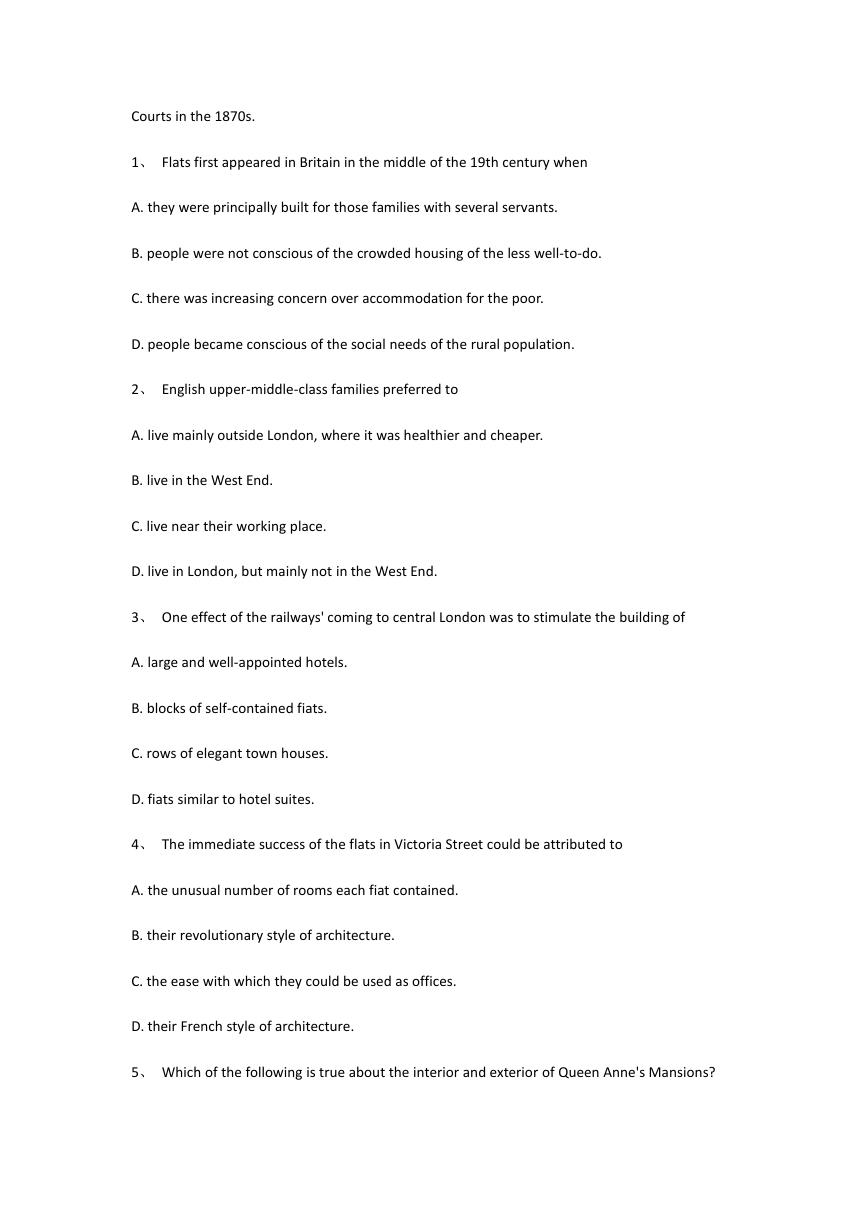
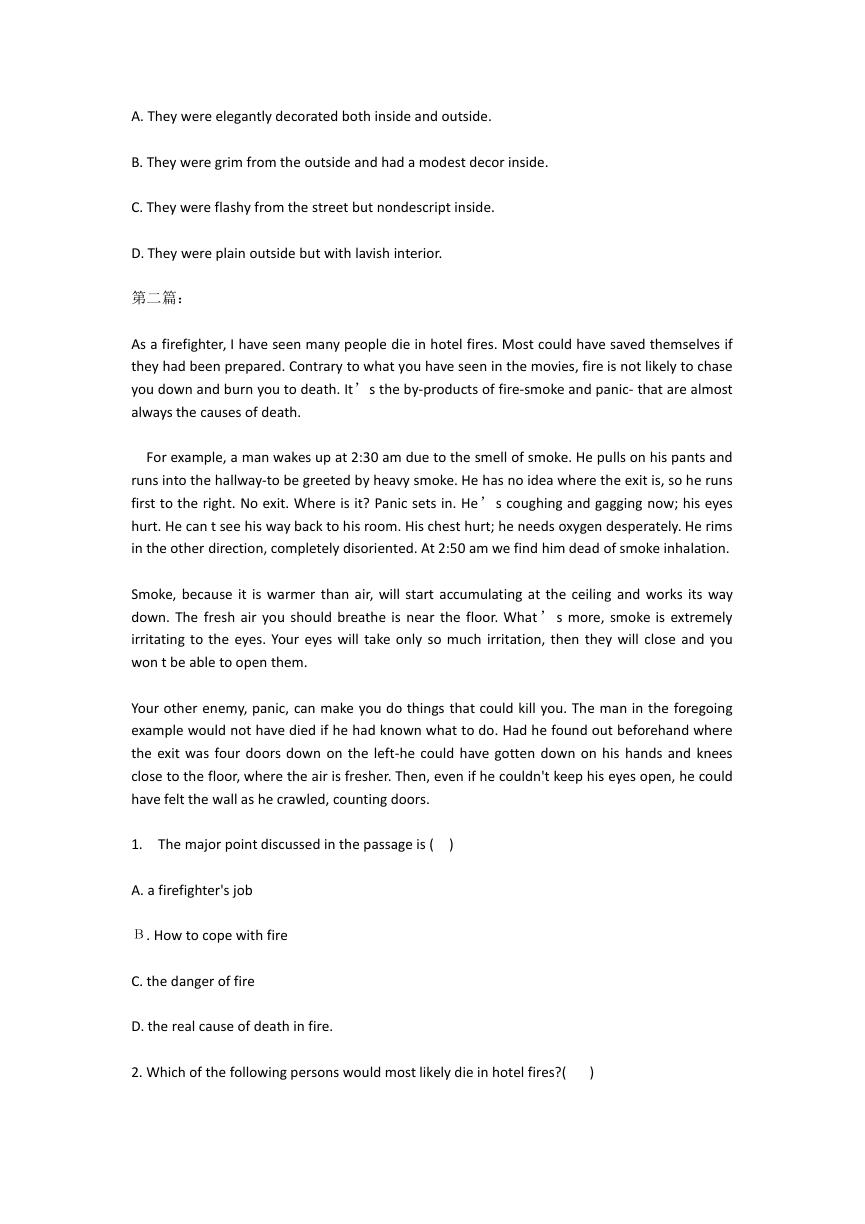
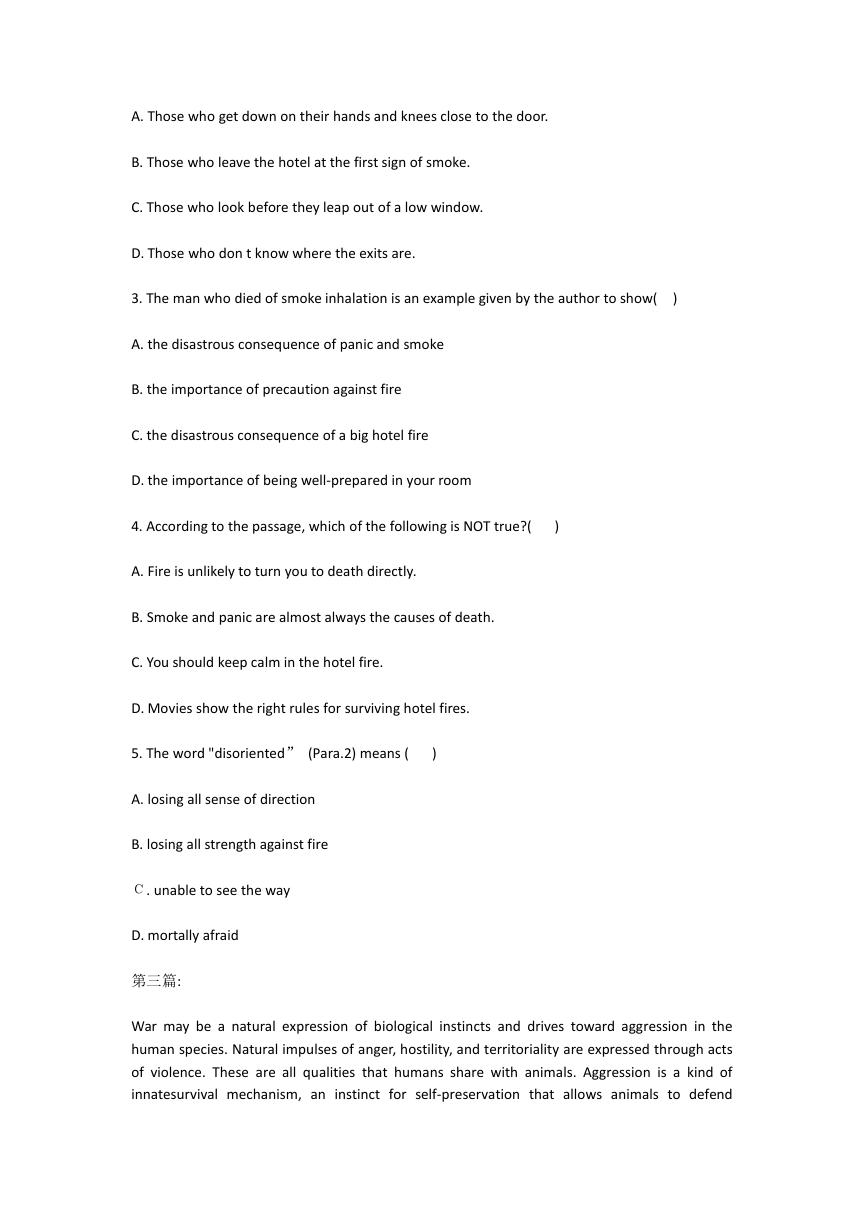
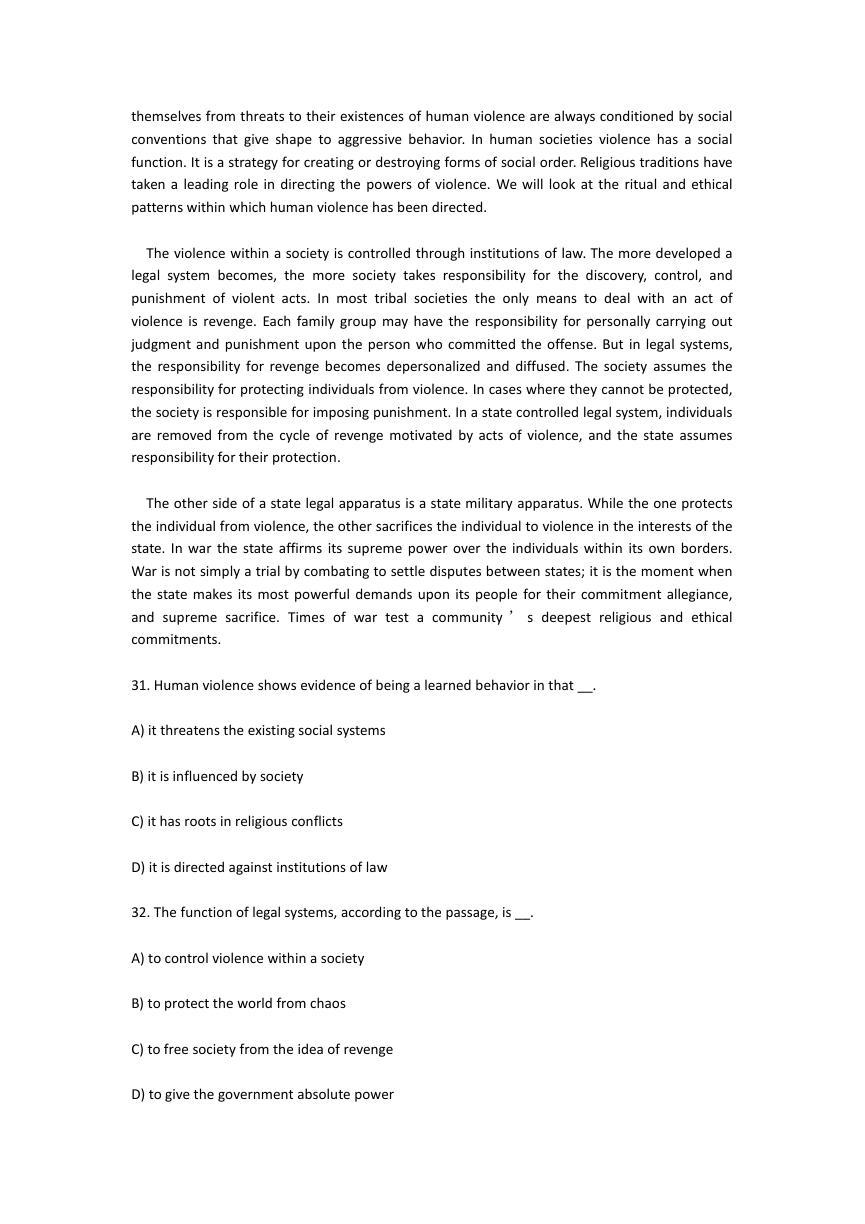
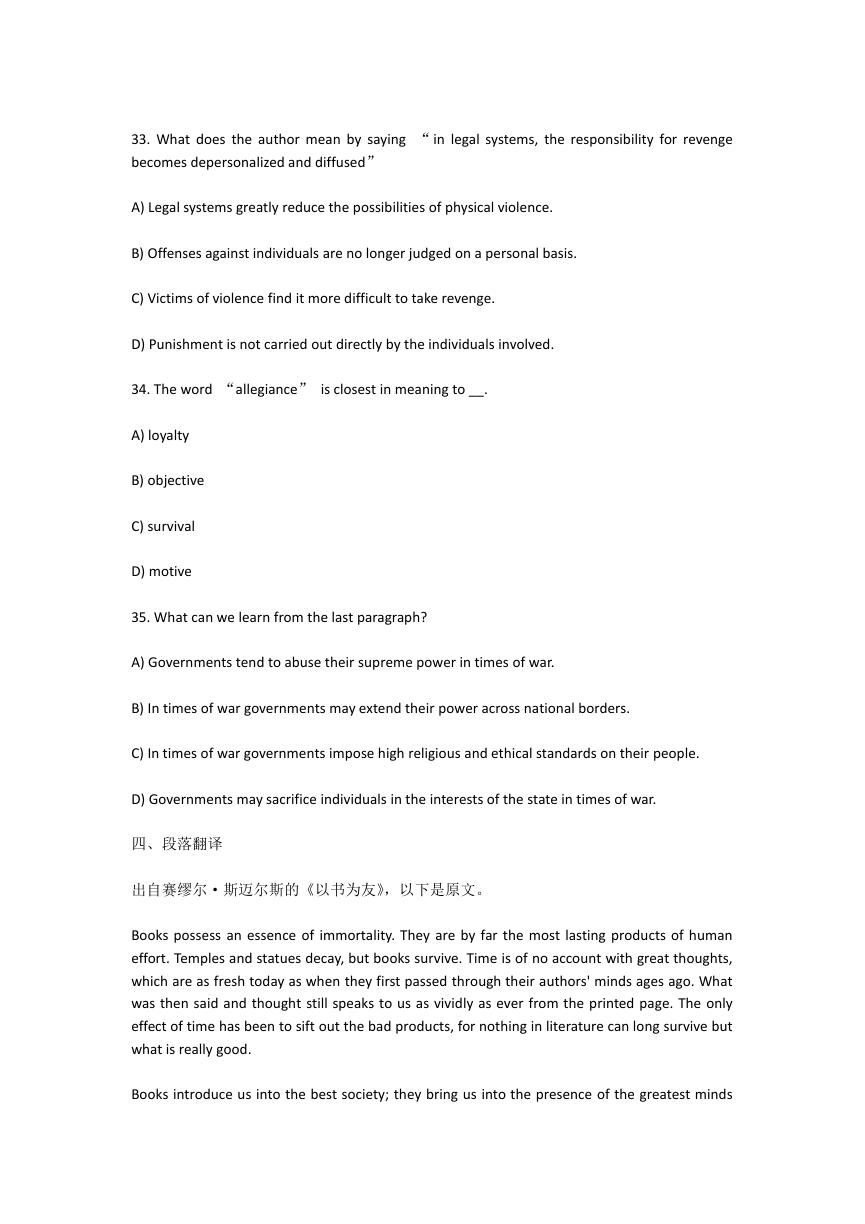








 2023年江西萍乡中考道德与法治真题及答案.doc
2023年江西萍乡中考道德与法治真题及答案.doc 2012年重庆南川中考生物真题及答案.doc
2012年重庆南川中考生物真题及答案.doc 2013年江西师范大学地理学综合及文艺理论基础考研真题.doc
2013年江西师范大学地理学综合及文艺理论基础考研真题.doc 2020年四川甘孜小升初语文真题及答案I卷.doc
2020年四川甘孜小升初语文真题及答案I卷.doc 2020年注册岩土工程师专业基础考试真题及答案.doc
2020年注册岩土工程师专业基础考试真题及答案.doc 2023-2024学年福建省厦门市九年级上学期数学月考试题及答案.doc
2023-2024学年福建省厦门市九年级上学期数学月考试题及答案.doc 2021-2022学年辽宁省沈阳市大东区九年级上学期语文期末试题及答案.doc
2021-2022学年辽宁省沈阳市大东区九年级上学期语文期末试题及答案.doc 2022-2023学年北京东城区初三第一学期物理期末试卷及答案.doc
2022-2023学年北京东城区初三第一学期物理期末试卷及答案.doc 2018上半年江西教师资格初中地理学科知识与教学能力真题及答案.doc
2018上半年江西教师资格初中地理学科知识与教学能力真题及答案.doc 2012年河北国家公务员申论考试真题及答案-省级.doc
2012年河北国家公务员申论考试真题及答案-省级.doc 2020-2021学年江苏省扬州市江都区邵樊片九年级上学期数学第一次质量检测试题及答案.doc
2020-2021学年江苏省扬州市江都区邵樊片九年级上学期数学第一次质量检测试题及答案.doc 2022下半年黑龙江教师资格证中学综合素质真题及答案.doc
2022下半年黑龙江教师资格证中学综合素质真题及答案.doc